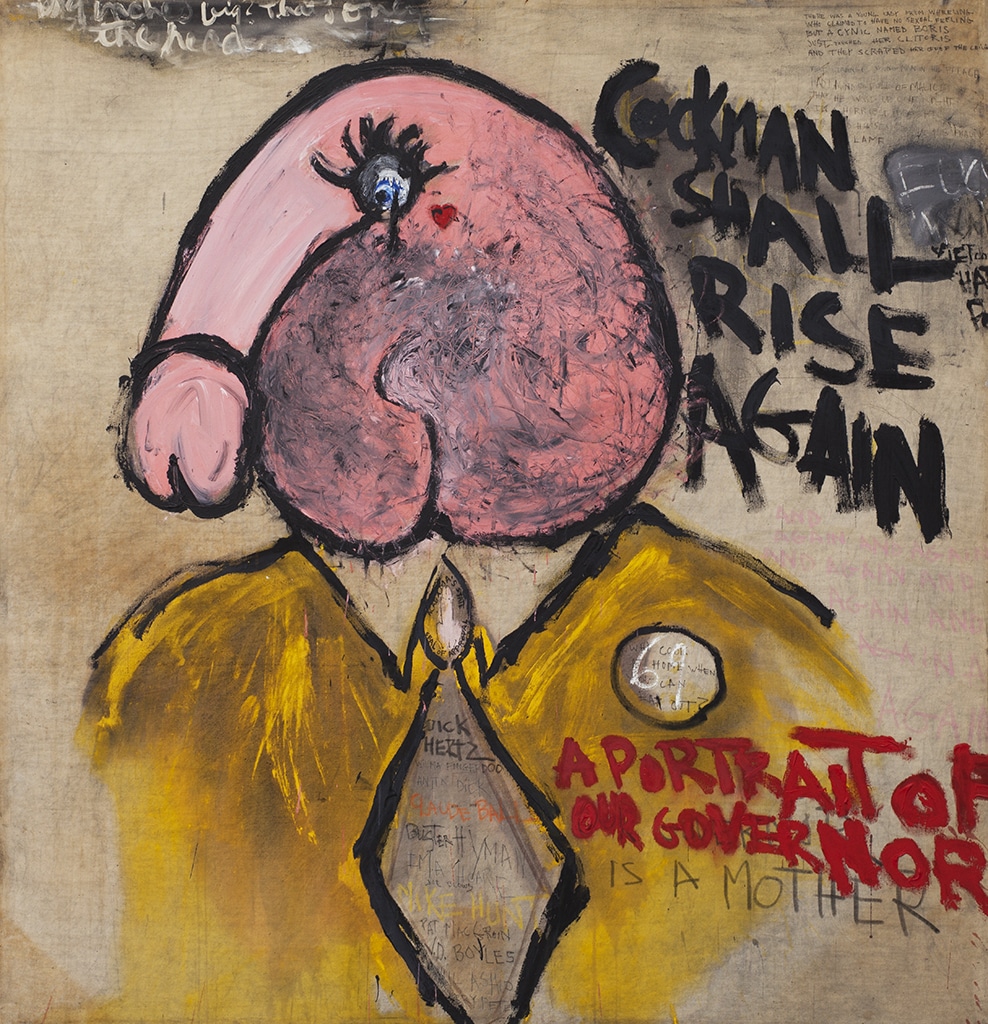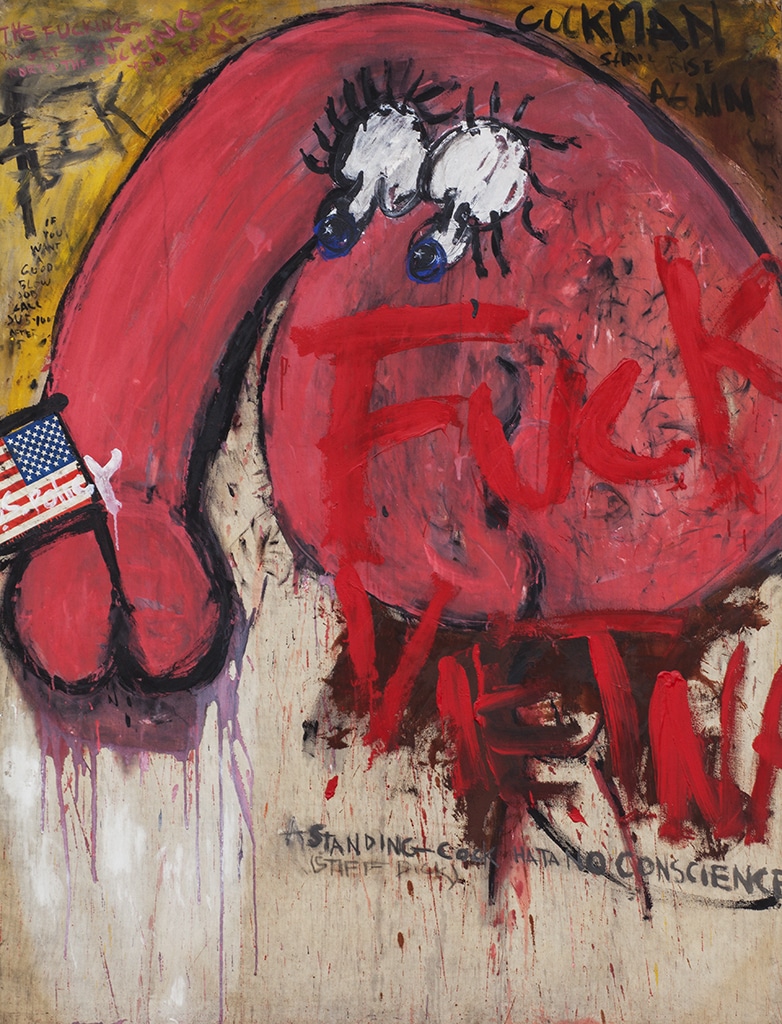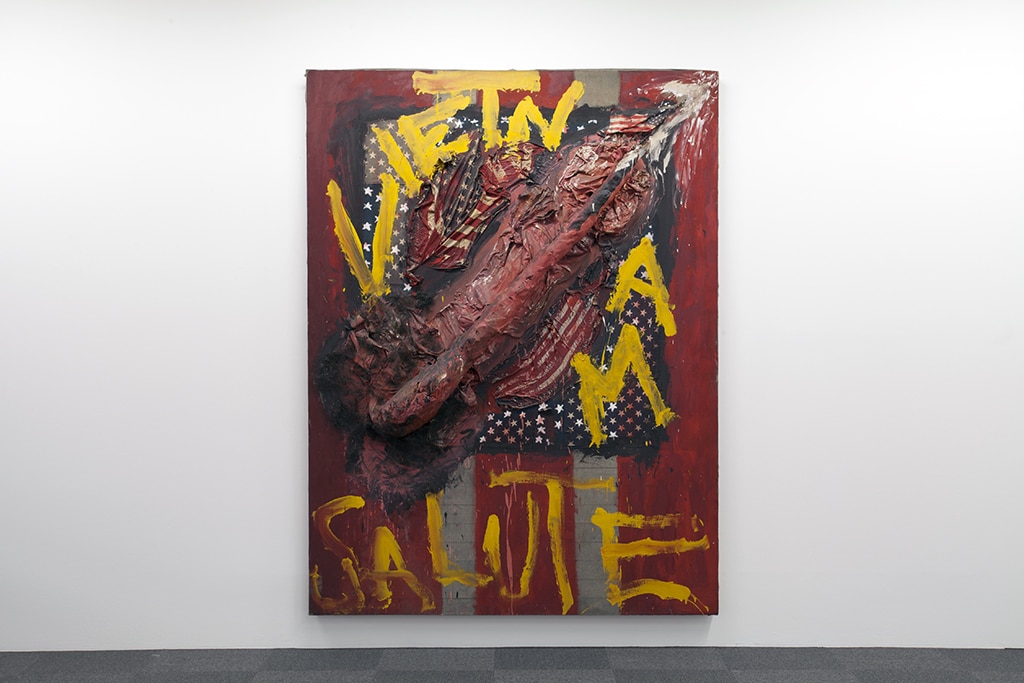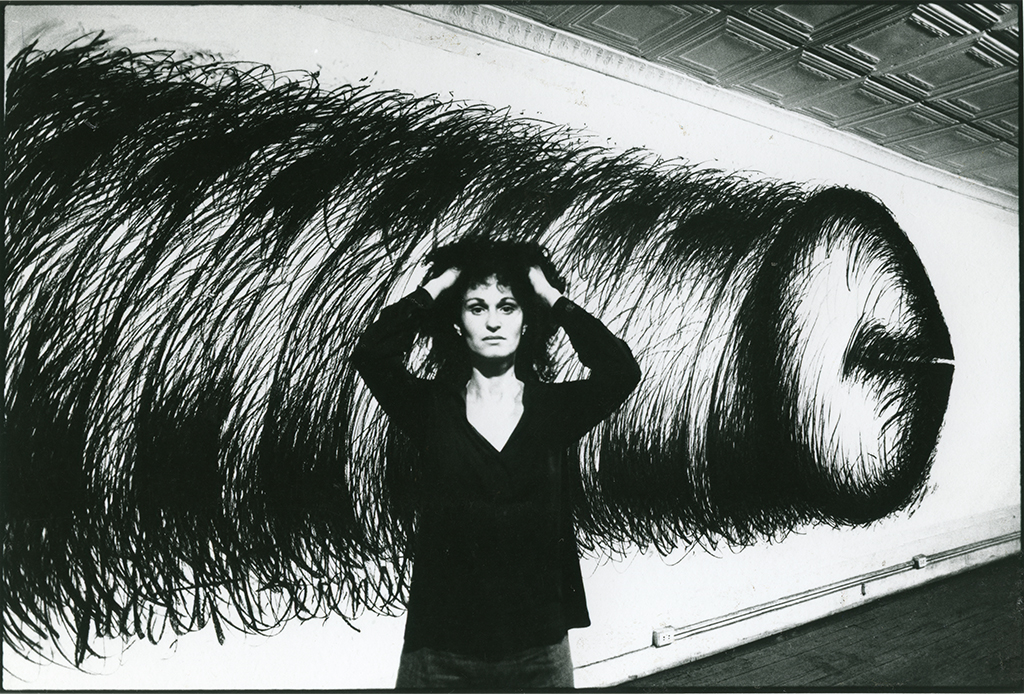It is only sexual on the surface, but it addresses the psychological and social constructs associated with the male phallus. Not everyone reads a large sex organ in the same way. 1
- https://kunsthallstavanger.no/nb/blog/interview-judith-bernstein
Reading Sex Objects / Reading Surfaces
Red and white bars alternate unevenly to form the ground of a painting by Judith Bernstein, Vietnam Salute, from 1967. Black paint meant to border the work’s central panel—a grid of white stars on navy—spills and drips, excessive of its task. A phallic form sprawls across this hastily constructed ground, emerging from a mess of red paint that does not look clean enough to be merely blood. The word “Vietnam” hangs awkwardly, broken at its center, on the margins of the mess, while Bernstein has scrawled its companion, “Salute,” more coherently across its bottom edge.
Vietnam Salute—like many of Bernstein’s work from the Fuck Vietnam series—is a mixed media painting. It has no clear surface to read. The phallic form in its center is an object made from a tightly rolled American flag. Several smaller cloth flags are also pasted onto the painting. Fabric is bunched beneath the phallus, both cushioning its sheath protectively and extending its protrusion into the viewer’s space. The work could depict either wound or womb, either muddy amniotic fluid or the bloody discharge of a disemboweled person.
The words—both in content and structure—were inspired by graffiti on the walls of public toilets at Yale University, where Bernstein studied for her MFA in the 1960s. On the subject of her forays into the men’s room, she told Julie L. Belcove of New York Magazine: “I had to do research. I felt that while you’re defecating, you’re also going into your subconscious. I thought it was an interesting connection — to defecate and then to just write something that comes to your head." 2
- http://www.vulture.com/2015/05/judith-bernstein-isnt-afraid-of-dirty-words.html
I don’t just mean “public” in the sense that artworks exist in public, as objects to be viewed. Bernstein’s work is also public in the sense that it provoked a strong public response: it was censored from a student show at Yale, from Women’s Work—American Art 1974 at the Philadelphia Civic Center, and even Kodak refused to print her slides. 3
- http://www.brooklynrail.org/2015/04/art/judith-bernstein-with-corina-larkin
Speaking with Corina Larkin of the Brooklyn Rail in 2015, Bernstein brings up another important question about the responsibility for expressing a relationship between war and masculinist fantasies:
Bernstein: … So men just write whatever, and it’s all anonymous. It’s not something that’s taken outside the bathroom, and no one signs it. [Laughs.]
Rail: Whatever you write on a bathroom wall, you’re not taking responsibility for it.
Bernstein: I take responsibility. 4
- Ibid.
The interviewer moves on quickly from this exchange, summarizing Bernstein’s gesture as a cooption of the act of graffiti, or as evidence of Bernstein’s insistence “on talking about what nobody is really willing to talk about: the complexity of male power and violence and the complexity of female power, rage, anger, and strength." 5
- Ibid.
In the epigraph to this text, Bernstein argues that her appropriation of the phallus should be read as a polyvalent gesture. A large sex organ can mean different things to different viewers. But her work also asks that the viewer/reader recognize language as polyvalent. Words mean one thing among men and quite another when Bernstein signs it.



War Sexuality
Bernstein’s work is often compared to Nancy Spero’s work, although Bernstein began the Fuck Vietnam series before Spero’s drawings on a similar theme. 6
- Ibid.
"Cartoon erections detonate male bombs in ecstatic displays of sexual sadism. A sperm bomb ejaculates a toxic cloud. Female bombs rain blood. Bombs shit infant heads. Conflating sex and violence, Spero’s imagery renders the two inseparable, indistinguishable, coextensive. For a defining theme of the War Series is war sexuality." 7
- Mignon Nixon “Spero’s Curses*,” October (Fall 2007) No. 122, pg. 20
According to Nixon, Spero pictures war sexuality as a “hysterical sexuality,” or a sexualized form of violence that is itself a response to the traumatic experience of war. Nixon relies on Juliet Mitchell’s theorization of war sexuality, which is not a combination of two separate psychic forces, the sexual drive and the aggressive (death) drive. Rather, war subordinates sexuality to the death drive, or sexualizes violence. 8
- Nixon, “Spero’s Curses*,” 18. Cites Juliet Mitchell, Mad Men and Medusas: Reclaiming Hysteria (New York, NY: Basic Books, 2000), pgs. 129 and 135.
- http://www.vulture.com/2015/05/judith-bernstein-isnt-afraid-of-dirty-words.html
War is a hysterical environment, one that forces people to displace the hysteria they feel when exposed to it. One way people displace their hysteria is to project it onto those perceived to be critical, or those who pose a threat to the sovereignty of the subject—the bathroom critics, the feminist artists making fun of the war effort by ridiculing the gun, the flag, and the phallus. Spero’s War Series, Nixon argues, dramatized “the hysteria that is projected onto political resistance as the protests of victims and critics alike are “put down” as “irrational,” dismissed as impotent rage.” 10
- Nixon, “Spero’s Curses*,” 20.
Yet the difference Bernstein insists on between her work and that of Spero and others from this period using hypersexual imagery to critique war is significant. Spero’s drawings turn the whole body into a weapon by anthropomorphizing helicopters and planes, or by representing the body to which the phallus-gun is attached. The bodies in Spero’s works are fragile. They seem emotional in a very human sense, even as airplane doing unspeakable things in war. Bernstein’s work, by comparison, is disembodied; she rarely offers the viewer the narrative relief of some form with which the viewer might identify. Even when she admits the body in paintings like Cockman #1 (Alabama’s Governor George Wallace) from 1966, it remains metonymic, a suit and tie.
For all its crude and graphic fanfare, Fuck Vietnam also represents language as a system of signs. In another painting from the series, Fucked by Number from 1967, Bernstein conflates statistical and quantitative languages and graffiti. She varies the scale of language in Cockman #1, juxtaposing tiny lines of script with large painted phrases. Bernstein grants the word and the phallus equal real estate in her paintings.
Spero’s drawings look mute by comparison, a fact Nixon argues is the result of the culture of war. She writes that “[w]ar … is hysterical in its very recourse to action in preference to speech. The culture of war is one in which hysterical effects proliferate as enactment, or acting out, triumphs over representation." 11
- Ibid.

The Value of a Screw
In an article problematically titled, “How to Screw Your Way to the Top: Judith Bernstein Brings Her Signature Style to the New Museum,” Michael H. Miller from The Observer describes Bernstein’s classic screw paintings from the 1970s as “massive curved charcoal scratches on paper that converge into an abrasive, bulbous form, the combination of a screw and a phallus." 12
- http://observer.com/2012/10/how-to-screw-your-way-to-the-top-judith-bernstein-brings-her-signature-style-to-the-new-museum/
- Ibid.
A 9-foot by 12.5-foot screw drawing entitled >i>Horizontal from 1974 was pulled from an exhibition at the Philadelphia Civic Art Center because the Center’s director at the time, John Pierron, could see no “redeeming social value in the work.” 13
- Pierron gave an interview to the Philadelphia Evening News, cited in http://observer.com/2012/10/how-to-screw-your-way-to-the-top-judith-bernstein-brings-her-signature-style-to-the-new-museum/
What I find particularly striking about Miller’s review, which was written in 2012, is how close his language is to language used to dismiss Bernstein’s work in the 1970s. Miller describes Horizontal as a “big black phallus with hairy charcoal lines protruding out of it...” Miller finds Horizontal “particularly coarse,” meaning rude, uncivilized, rough in its texture and social manners. He also jokes, in the title of his article, about Bernstein “screwing her way to the top” with her giant representations of a black male sex organ. However inadvertently, he draws on the language of racial stereotypes to describe an unacceptable object—an object that threatens him, perhaps—just as he uses sexually explicit language games in the title of the article to describe Bernstein’s success as the result of her sexuality. 14
- I cannot go into the racial subtext here, but I think it is significant that the threatening object menaces whiteness, or draws on the fears of a white majority about the black male body.
In 2008, Mitchell Algus invited Bernstein to put on a solo show in his gallery in New York. The exhibition proved to be her reintroduction to the mainstream art world after being ignored since the 70’s. In theory, the rules of the game had changed. But Miller’s explanation for the initial invitation still reads to this feminist as shockingly sexist. He quotes Algus:
“I was aware of her work from looking through old magazines,” Mr. Algus told me.
“There’s a famous picture of Judith standing in front of one of the screw drawings, holding this mane of black hair up in the air. Being a young man at the time, I physically remembered that.” 15
- http://observer.com/2012/10/how-to-screw-your-way-to-the-top-judith-bernstein-brings-her-signature-style-to-the-new-museum/
Miller articulates the impetus for Bernstein’s delayed professional recognition as desire, male desire, and the prerogative of the male gaze. I do not wish to condemn Mitchell Algus, who has a long track record of supporting feminist artists in New York. 16
- http://observer.com/2012/05/odd-couple-mitchell-algus-and-amy-greenspon-are-showing-and-yes-selling-the-unknown-the-emerging-the-dead/
Perhaps the real issue with her screw drawings is precisely that they lack the coarseness of her earlier work and therefore cannot be dismissed as an irrational representation of the phallus. The drawings’ gestural language remains industrial, impersonal. Looking beyond the surface of her Screw drawings, I see in Bernstein’s early screw drawings a pre-mature manifestation of Pac Man, the minimalist Japanese video game character released in 1980 that came to symbolize an American generation born into extraordinary consumption. I see a hungry mouth searching for more, endlessly. I see voracious American capitalism figured as a part-object, surging up from the ground or across a wall.

Bio:
Natasha Marie Llorens is an independent curator and writer based in New York and Marseille. Recent projects include “Syntagma,” at Eugene Lang College at the New School and “Vois-tu pas que je brûle? (Do you not see…)” at the Essex Street Market with Artists Alliance, both in Manhattan. She is a graduate of the Center for Curatorial Studies at Bard College and a Ph.D. candidate in art history at Columbia University. Her academic research is focused on violence and representation in Algerian national cinema from the period immediately post independence.

